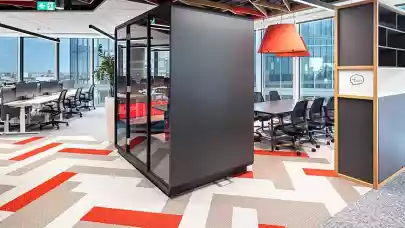
More than three-quarters (76%) of Europe’s office buildings are at risk of obsolescence by the end of this decade unless landlords invest in improvements or find alternative uses for it. This is the warning from Cushman & Wakefield in its latest report.
The combination of changing work patterns, occupier demand, increasing legislative action from European governments around minimum sustainability standards, as well as an uncertain economic backdrop are the key factors underpinning the risk to office assets.
Sustainability, both in terms of legislation and occupier expectation, is a significant driving force in Europe, and landlords are being urged to act now to mitigate the impact on their portfolios. Offices below a certain level of energy performance are under threat of legal obsolescence. In the UK, for example, commercial buildings must have a minimum EPC rating of E by April 2023, increasing to B by 2030.
Across Europe, hybrid working patterns have also led office occupiers to seek out higher-quality workplaces meeting the latest environmental, well-being and digital connectivity standards. This top-quality space accounted for over half (54%) of total European office demand between 2019-2022. This trend is expected to intensify as demand exceeds supply in many markets including Prague, Budapest, Milan, Warsaw, Madrid, Barcelona, and London.
In contrast, around half of Europe’s existing office stock is over 30 years old and only 14% has been built or substantially modernised in the past 10 years, requiring landlords to upgrade space or risk it dropping to a lower grade. Cushman & Wakefield’s analysis estimates that current office stock can be split as follows:
- Top: around 24%, built in the last decade, fits modern office usage and is in high demand
- Middle: a large proportion of 62% requires repositioning to avoid deterioration
- Bottom: 14%, ageing, non-updated stock that is in many ways already obsolete
James Young, Head of Investor Services EMEA & APAC, Cushman & Wakefield, said: “The office sector is facing a critical chapter of necessary adaptation, evolution, and recalibration. Across Europe there is strong demand for offices, but occupiers drive the market and they are increasingly focused on the very best workplaces. For owners of older, lower-quality assets, doing nothing is not a strategy. Landlords that reinvest in sustainability credentials, amenities, sense of place and community engagement to move their assets into top-quality ratings will benefit from this flight to quality. Those that do not will face diminishing returns.”
The report predicts a growing imbalance between available top-grade space and an increase in the stock that could be obsolete or has the potential to be so unless immediate action is taken.
A wide breadth of solutions can address the sustainability requirements and the exacting needs of the modern tenant. Reimagination strategies proven to work well in terms of preserving income and capital value growth include:
- Repositioning the asset to upgrade its amenities and sustainability, as well as its sense of place through community-oriented offerings and events.
- Repurposing all or some of the office for other uses, such as residential, industrial, life sciences or healthcare.
Young added: “There is much to be gained even by those facing the stiffest of headwinds. Addressing the challenge head-on with a proactive, creative, and strategic approach will help owners and investors recover value and generate returns. It is important when doing so to assess each office individually, as well as in the context of broader portfolios. There is no ‘one size fits all solution’ but learnings from around the world can allow evolution to take place in a measured and intentional manner.”



